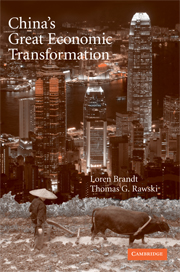Book contents
- Frontmatter
- Contents
- List of Figures
- List of Tables
- Contributors
- Acknowledgments
- Map
- 1 China's Great Economic Transformation
- 2 China and Development Economics
- 3 China in Light of the Performance of the Transition Economies
- 4 A Political Economy of China's Economic Transition
- 5 The Demographic Factor in China's Transition
- 6 The Chinese Labor Market in the Reform Era
- 7 Education in the Reform Era
- 8 Environmental Resources and Economic Growth
- 9 Science and Technology in China
- 10 The Political Economy of Private Sector Development in China
- 11 The Role of Law in China's Economic Development
- 12 China's Fiscal System: A Work in Progress
- 13 Agriculture in China's Development: Past Disappointments, Recent Successes, and Future Challenges
- 14 China's Financial System: Past, Present, and Future
- 15 China's Industrial Development
- 16 China's Embrace of Globalization
- 17 Growth and Structural Transformation in China
- 18 Income Inequality during China's Economic Transition
- 19 Spatial Dimensions of Chinese Economic Development
- 20 Forecasting China's Economic Growth to 2025
- Index
6 - The Chinese Labor Market in the Reform Era
Published online by Cambridge University Press: 24 May 2010
- Frontmatter
- Contents
- List of Figures
- List of Tables
- Contributors
- Acknowledgments
- Map
- 1 China's Great Economic Transformation
- 2 China and Development Economics
- 3 China in Light of the Performance of the Transition Economies
- 4 A Political Economy of China's Economic Transition
- 5 The Demographic Factor in China's Transition
- 6 The Chinese Labor Market in the Reform Era
- 7 Education in the Reform Era
- 8 Environmental Resources and Economic Growth
- 9 Science and Technology in China
- 10 The Political Economy of Private Sector Development in China
- 11 The Role of Law in China's Economic Development
- 12 China's Fiscal System: A Work in Progress
- 13 Agriculture in China's Development: Past Disappointments, Recent Successes, and Future Challenges
- 14 China's Financial System: Past, Present, and Future
- 15 China's Industrial Development
- 16 China's Embrace of Globalization
- 17 Growth and Structural Transformation in China
- 18 Income Inequality during China's Economic Transition
- 19 Spatial Dimensions of Chinese Economic Development
- 20 Forecasting China's Economic Growth to 2025
- Index
Summary
INTRODUCTION
Since economic reforms began in 1978, the Chinese labor market has undergone a set of remarkable transformations that have dramatically affected the working lives and welfare of China's citizens. Like other rapidly growing developing countries, China has experienced a rapid structural change, featuring a steady flow of labor from agriculture to industry and from rural areas to urban areas. As a transition economy, China has shifted gradually from planned allocation of labor in state-sector jobs to a more open labor market, with increasing numbers of workers employed in the non state and private sectors. Table 6.1 summarizes the magnitude of these changes, drawing upon official data. From 1978 to 2005, the share of labor employed primarily in agriculture fell from 71 to 45 percent, the share of labor working in urban areas increased from 24 to 36 percent, and the share of urban labor working in the state-owned or government sectors fell from 78 to 24 percent.
Although the large magnitudes of these changes are impressive, reform of the labor market has been halting, uneven, and difficult, with much additional reform required if China is to complete its transition successfully while maintaining its rapid development trajectory. Many of the challenges of labor market reforms relate to the political difficulty of moving away from a set of institutions and policies that privileged the welfare of urban workers by guaranteeing employment in state enterprises and imposing strict restrictions on population mobility.
- Type
- Chapter
- Information
- China's Great Economic Transformation , pp. 167 - 214Publisher: Cambridge University PressPrint publication year: 2008
- 123
- Cited by



